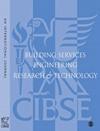基于蒙特卡罗模拟的电梯合同容量外乘客需求通用往返时间分析研究
IF 1.8
4区 工程技术
Q3 CONSTRUCTION & BUILDING TECHNOLOGY
Building Services Engineering Research & Technology
Pub Date : 2022-02-28
DOI:10.1177/01436244211069658
引用次数: 1
摘要
传统的电梯系统设计实践是计算高峰期间纯进入交通的往返时间(RTT)和相关参数,然后进行实时计算机模拟。最近的研究表明,正常交通要复杂得多,包括进出和楼层间的混合模式。在如此复杂的交通模式下,基于描述客运概率的适当始发地-目的地矩阵,6年前出现了分析计算通用RTT的重大突破。该成因模型通过假设一次往返行程内要求服务的乘客总数是有限的电梯合同容量来发挥安全作用,这符合传统的高峰到达RTT公式。在本文中,消除了这种假设,并基于蒙特卡罗模拟进行研究。研究发现,在不过多牺牲RTT和平均客运时间的情况下,有提高处理能力的空间,最高可达合同能力的两倍。这种现象,即超过合同容量的总乘客需求,只有在多个入口楼层和/或混合交通条件下才有效。这种方法可以防止设计过于现实。实际应用:根据ISO 8100:32:2020和CIBSE指南D:2020,建议电梯系统设计师在进行任何实时计算机模拟之前进行RTT和相关参数的计算。电梯行业几十年来一直采用这种做法。然而,传统的RTT评估主要针对高峰期间的纯传入流量。2014-2015年开发的通用RTT计算方法扩展了RTT评估,以涵盖现代建筑的主要和复杂交通模式,但一次往返行程内处理的假定乘客数量仅限于电梯的合同容量。本文进一步消除了这一限制,用合理的RTT和平均客运时间来评估处理能力的限制。然后,通用RTT方法可以更加现实和推广,并防止过度简化系统设计。本文章由计算机程序翻译,如有差异,请以英文原文为准。
A study on universal round trip time analysis for passenger demand beyond elevator contract capacity by Monte Carlo simulation
The traditional elevator system design practice is to calculate the round trip time (RTT) and associated parameters of pure incoming traffic during up-peak, followed by real-time computer simulation. Recent studies indicated that the normal traffic is much more complicated, consisting of a mixture of incoming, outgoing and interfloor patterns. A major breakthrough to analytically calculate the Universal RTT, under such complicated traffic patterns, emerged 6 years ago based on an appropriate origin-destination matrix describing the passenger transit probability. That genesis model played safe by assuming that the total number of passengers demanding service within one round trip is limited elevator contract capacity, which is in line with the traditional up-peak incoming RTT formulae. In this article, such assumption is removed and the study is based on Monte Carlo simulation. It is found that there is room for enhancing the handling capacity, up to two times the contract capacity, by not sacrificing the RTT and average passenger transit time by too much. This phenomenon, that is, total passenger demand beyond contract capacity, is only valid under the existence of multiple entrance floors and/or mixed traffic conditions. This approach may prevent oversizing the design which could be more realistic. Practical applications: Elevator system designers, according to ISO 8100:32:2020 and CIBSE Guide D: 2020, are recommended to carry out calculation of the RTT and related parameters before any real-time computer simulation. This practice has been adopted by the elevator industry for decades. However, conventional RTT evaluation is mainly on pure incoming traffic during up-peak. The Universal RTT calculation method developed in 2014–15 extended RTT evaluation to cover dominant and complicated traffic patterns of modern buildings, but the assumed number of passengers to be handled within one round trip was limited to the contract capacity of the elevator. This article further removes this limitation to evaluate the limit of handling capacity with reasonable RTT and average passenger transit time. Then, the Universal RTT method could be more realistic and rolled out, and prevent oversizing the system design.
求助全文
通过发布文献求助,成功后即可免费获取论文全文。
去求助
来源期刊

Building Services Engineering Research & Technology
工程技术-结构与建筑技术
CiteScore
4.30
自引率
5.90%
发文量
38
审稿时长
>12 weeks
期刊介绍:
Building Services Engineering Research & Technology is one of the foremost, international peer reviewed journals that publishes the highest quality original research relevant to today’s Built Environment. Published in conjunction with CIBSE, this impressive journal reports on the latest research providing you with an invaluable guide to recent developments in the field.
 求助内容:
求助内容: 应助结果提醒方式:
应助结果提醒方式:


